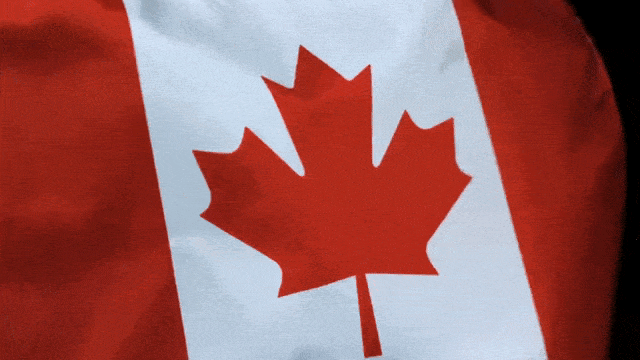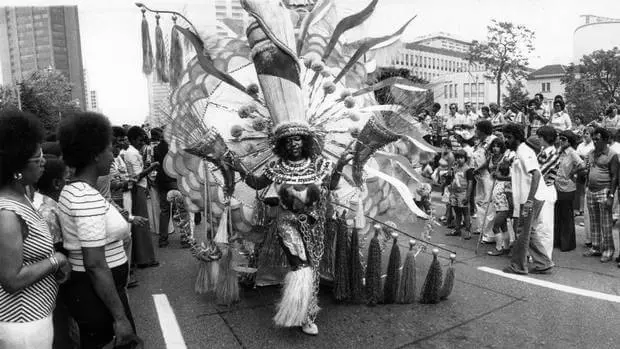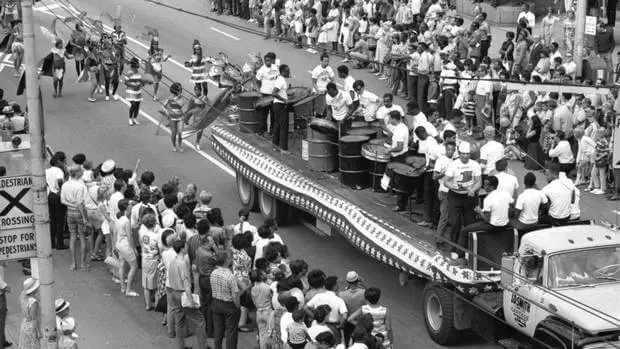YOUR CARIBANA GUIDE
TORONTO’S CARNIVAL SCENE
JUMP UP IN THE PARADE
CARIBANA’S CONTRIBUTION
CARIBANA’S HISTORY
jump up in the parade

MAS BAND
Carnival costumes commonly referred to as Mas, short for ‘masquerade’, are one of the key elements of the Grand Parade. They are designed by a bandleader or his team to reflect a different theme each year. Participants who wish to be a part of the parade can select a costume of their choice with a Mas Band which allows for direct access to partake and dance through the parade route.
The Grand Parade is not only a showcase of colourful artistic expression, it is an intense competition of creative street theatre and pageantry.
The Mas is the heart of the Carnival.


Steelbands OSA
Ontario Steelpan Association is the culmination of an initiative by avid steelpan enthusiasts to promote and preserve their musical art-form in Canada through an umbrella organization.
Steelpan (steel drum), the only musical instrument created in the 21st century, is the main percussion instrument in the annual carnival festivities. Though created in the 1930s, steel pan history can be traced back to the enslaved Africans who were brought to the Caribbean during the 1700s. The creation of the Steelpan evolved out of resistance in the banning of African culture and hand drumming traditions. The slaves crafted instruments and kept elements of their culture alive through the inventions like the “tamboo bamboo and accompaniment of the “bottle and spoon”. The Steelpan is not only a musical instrument, it is a symbol of resilience.
Steelpan is the pulse of the Carnival.

Dance and Performing Arts
Afro-Caribbean Dance is a blend of history, customs, and fluid movement that evolved from complex influences, including slavery and colonialism. Various styles such as the mambo, calypso dance and limbo emerged when enslaved Africans, were brought to the islands to work on the plantations, and carried customs and drumming traditions with them. Eventually, new music and dance were created with the mixing of influences of French and Spanish colonists and indigenous culture. Movement through dance is performing art and storytelling and connection to the past.
Dance is the rhythm of the Carnival.


Artistes OCPA
The Organization of Calypso Performing Artistes (OCPA) is a non-profit organization, which was founded in 1981 by a group of community-based individuals who saw the need for an umbrella group to facilitate the growth and development of the Calypso art form in Toronto and Canada. This organization represents homegrown talent who write, create and perform original compositions and who pride in sharing Soca and Calypso with all cultures in Toronto and beyond.
Music is the beat of the Carnival.

CARIBANA’S CONTRIBUTION
Festival has grown by leaps and bounds into a driving force in the City of Toronto celebrating Caribbean arts and culture. It has placed Toronto on the international map as a world class city, and it has provided hundreds of millions of dollars of economic activity annually for the City, Province, and Federal Governments. Celebrated as the Largest Street Festival of its kind in North America, we are proud to share its vibrancy and cultural extravaganza in one of the most multiethnic, multicultural, and multi-religious cities in the world.


There have been a number of studies completed (Price Waterhouse, City Task Force and Ryerson University) and they all state that the CARIBANA festival generated over 300 million dollars in the early nineties. Moreover, accordingly to Ryerson University’s latest study they estimated that the festival was generating enormous amounts of revenue for the local restaurants, retailers, hotel and airlines industries etc,. It was estimated that CARIBANA generated over $438 million dollars of economic activity in Toronto annually, and over $2 billion dollars of economic activity for the city and $1 billion dollars of tax revenue between the province and the city, according to Ryerson University’s latest study of 2010.
CARIBANA’S HISTORY
The CARIBANA festival was established in 1967, by invitation of the province of Ontario to join in celebrating Canada’s 100th birthday. A group of professionals formed a board, and with a dedicated and committed group of volunteers, community support and a number of well wishers CARIBANA was born.
The first Saturday in August culminates as a meeting place for people all over the world to celebrate the explosion of Caribbean culture with music, dance, street theatre and sumptuous mouth watering food for the great number of multicultural pallets in our City.


The CARIBANA festival driven by community volunteers, initially did not receive any funding from any of the levels of government. Therefore staging of the Festival, was accomplished by Board members, Volunteers and community support and a number of well wishers. In its later years the Province provided a small amount of funds which proved insufficient to stage the Festival, leaving board members, volunteers and community support to dip into their own pockets to support the Festival. It is a fact that quite a few mortgaged their homes to ensure that the Festival would be staged.
